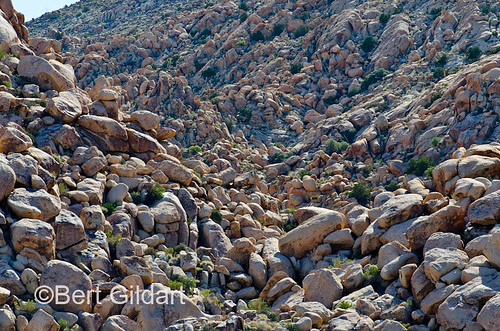What Happened? This Brobdingnagian Landscape May Blow Your Mind
©Bert Gildart: If there is a boulder field in Joshua Tree or one of the other national parks that has a greater “wow” factor than does this one, I can’t recall it.
We saw this immense scattering or rocks while hiking in Anza Borrego Desert State Park’s Indian Hill country. This field of rock stretched for half a mile, and if you look closely at the associated photograph, you’ll see some of the rocks are rounded while others assume a more elongated configuration.
What happened?
I am not a geologist but after seeing this pile of rocks, this “Brobdingnagian landscape” as one author called it — referring to Gulliver’s travels (by Jonathan Swift) through the land of giants – I had to buy several books and try to recall college courses.
CLICK FOR LARGER IMAGE AND TO BETTER SENSE THE MAGNITUDE
Synthesizing information from a geology book authored by Park Ranger Paul Remeika, my understanding is that about 100 million years ago various forces pushed a molten mass to the earth’s surface and into the overlying sedimentary rock. Depositions of these sediments preceded this molten mass by millions of years and were laid down from materials transported by inland seas.
As the granite connected with the pre-existing sedimentary rock it solidified and then crystalized, which tends to set up areas of weakness. These areas take the form of “joints,” or horizontal and vertical fracture lines. With time the process of erosion further weakens the joints and they fragment into huge granitic rock masses. Wind, rain, freezing and thawing further modify their appearance whereupon elongated rocks become smaller and more rounded.
Similar processes have occurred in other areas of the park such as at Culp Valley. Particularly impressive were the fields of boulders I saw several weeks ago off the trail and above Alcoholic Pass.
But nothing I’ve ever seen seems to match the Brobdingnagian landscape near Indian Hill, which simply blew my mind.
—————————————————————————


